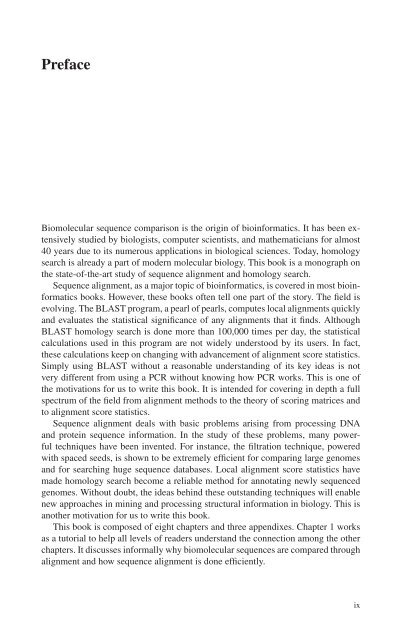You also want an ePaper? Increase the reach of your titles
YUMPU automatically turns print PDFs into web optimized ePapers that Google loves.
Preface<br />
Biomolecular sequence comparison is the origin of bioinformatics. It has been extensively<br />
studied by biologists, computer scientists, and mathematicians for almost<br />
40 years due to its numerous applications in biological sciences. Today, homology<br />
search is already a part of modern molecular biology. This book is a monograph on<br />
the state-of-the-art study of sequence alignment and homology search.<br />
<strong>Sequence</strong> alignment, as a major topic of bioinformatics, is covered in most bioinformatics<br />
books. However, these books often tell one part of the story. The field is<br />
evolving. The BLAST program, a pearl of pearls, computes local alignments quickly<br />
and evaluates the statistical significance of any alignments that it finds. Although<br />
BLAST homology search is done more than 100,000 times per day, the statistical<br />
calculations used in this program are not widely understood by its users. In fact,<br />
these calculations keep on changing with advancement of alignment score statistics.<br />
Simply using BLAST without a reasonable understanding of its key ideas is not<br />
very different from using a PCR without knowing how PCR works. This is one of<br />
the motivations for us to write this book. It is intended for covering in depth a full<br />
spectrum of the field from alignment methods to the theory of scoring matrices and<br />
to alignment score statistics.<br />
<strong>Sequence</strong> alignment deals with basic problems arising from processing DNA<br />
and protein sequence information. In the study of these problems, many powerful<br />
techniques have been invented. For instance, the filtration technique, powered<br />
with spaced seeds, is shown to be extremely efficient for comparing large genomes<br />
and for searching huge sequence databases. Local alignment score statistics have<br />
made homology search become a reliable method for annotating newly sequenced<br />
genomes. Without doubt, the ideas behind these outstanding techniques will enable<br />
new approaches in mining and processing structural information in biology. This is<br />
another motivation for us to write this book.<br />
This book is composed of eight chapters and three appendixes. Chapter 1 works<br />
as a tutorial to help all levels of readers understand the connection among the other<br />
chapters. It discusses informally why biomolecular sequences are compared through<br />
alignment and how sequence alignment is done efficiently.<br />
ix

















